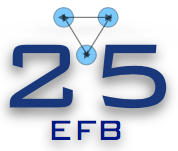Speaker
Description
In this contribution, we present some recent studies of the excited states of 4He nucleus, performed by accurately solving the four body scattering problem in the framework of the ab-initio hyperspherical harmonic method. The considered nuclear Hamiltonians include modern two- and three-nucleon interactions, derived using the chiral effective field theory approach.
First of all, we study the first excited state, which energy is slightly above the threshold for p+3H breakup, but below that of n+3He (this state is unbound due to the effect of the Coulomb repulsion between the protons [1]). Recently, an electron scattering experiment has allowed the extraction of accurate monopole transition form factor F(q) data from the 4He ground state to this first excited state [2]. Previous theoretical studies have shown that F(q) is very sensitive to the adopted nuclear interaction [3,4]. We will present new results for this observable obtained using the calculated four-body continuum wave functions.
Second, we present a study of the second excited state (a 0- resonance). For such a study, we exploit a recent measurement of the 3He(n,p)3H Ay observable using cold neutrons performed at ORNL [5]. In fact,
the energy of the process is close to the expected position of the 0- resonance. We found that the theoretical predictions for such observable are very sensitive to the interaction, in particular to the three-nucleon force.
Finally, we study the processes d(d,p)3H and d(d,n)3He at energies of interest for energy production and for big-bang nucleosinthesis [6]. In this case, we are sensitive to the presence of 1- resonant states in the 4He spectrum. We will present new results for the cross section and polarization observables of these processes and study the sensitivity to the position of 1- resonances.
These studies show that the spectrum of 4He is still poorly understood and that more accurate interactions between the nucleons are needed to quantitatively describe it.
[1] A. Kievsky et al., Ann. Rev. Nucl. Part. Sci. 71, 465 (2021)
[2] S. Kegel et al., Phys. Rev. lett. 130, 152502 (2023)
[3] S. Bacca et al., Phys. Rev. Lett. 110, 042503 (2013)
[4] E. Hiyama et al., Phys. Rev. C70, 031001(R) (2004)
[5] M. Gericke et al., (n3He Collaboration), Phys. Rev. Lett. 125, 131803 (2020)
[6] M. Viviani et al., Phys. Rev. Lett. 130, 122501 (2023)

